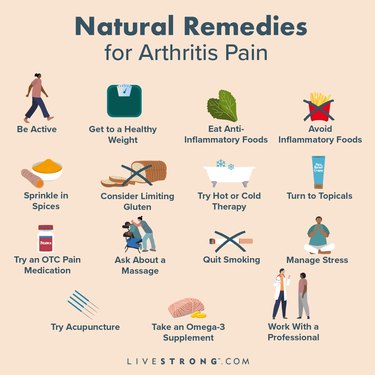
Pain from arthritis can be unpleasant to say the least, but there are a number of natural and over-the-counter home remedies for arthritis that can offer some relief and make everyday activities more manageable.
Arthritis statistics show more than 23 percent of adults in the U.S. have the condition, according to the Centers for Disease Control and Prevention (CDC). And while symptoms vary across the different types (there are more than 100), the most common markers include pain, redness, stiffness and swelling in the joints.
Video of the Day
Video of the Day
While there is no permanent cure for arthritis, you can take steps to manage your symptoms.
"Improving one's arthritis pain can and will be a lifelong journey," Maria Kyriacou, MD, a primary care sports medicine physician at Miami Orthopedics & Sports Medicine Institute in South Florida, tells LIVESTRONG.com. "There will be both good and bad days. However, the goal is to minimize the frequency of your bad days."
Here are some expert-approved home remedies for arthritis pain relief.

1. Be Active

"To this day, the best relief for arthritis pain is activity," says Zsolt Kulcsar, DO, MPH, Chief of Rheumatology at White Plains, Hospital in White Plains, New York.
Indeed, a September 2018 study in the Annals of the Rheumatic Diseases notes that for people with arthritis, regular exercise can reduce joint pain, help with managing weight (which can take some pressure off the joints), strengthen the muscles around the affected joints and combat fatigue.
"Exercising helps with all types of inflammatory arthritis," Robert Koval, MD, rheumatologist at Texas Orthopedics, tells LIVESTRONG.com. "This helps avoid the 'gelling' phenomenon, where patients feel more stiff when they slow down and rest. This is thought to be due to the fluid in the joints (synovial fluid) thickening, thus causing more pain with movement."
Which Type of Exercise Is Best?
The type of exercise you do matters. High-intensity, low-impact activities are usually recommended for anyone who has arthritis, Dr. Kulcsar says. Those might include:
- Walking
- Biking
- Swimming or other aquatic exercises
- Yoga
- Tai chi
"Yoga has been shown to provide extensive relief of stress and pain," Robert G. Lahita MD, PhD, director of the Institute for Autoimmune and Rheumatic Disease at Saint Joseph Health and author of Immunity Strong, tells LIVESTRONG.com. "It's a great way to combine meditation with stretching and exercise to produce immune benefits if done with regularity."
Dr. Kulcsar adds that tai chi can be very helpful because it can work small stabilizer muscles, which improves balance in the joints and helps reduce pain, while stretching helps promote range of motion in the joints to keep them healthy and moving freely.
And last but not least, Dr. Kulcsar recommends strength training for arthritis, because it can help support the joints that are affected. For instance, strengthening your quads (the front of your legs) through exercises like squats and leg presses can help with pain from arthritis in the knees, and core exercises can help with lower back pain.
"When you strengthen a muscle group, it gives more support, and your body is less reliant on the joint to carry a load," he says.
Exercise also helps reduce stress, is great for mental health and has been shown to decrease inflammation, Dr. Koval adds.
Tip
Aim for at least 150 minutes of moderate-intensity aerobic exercise each week, along with at least two strength-training sessions, per the Physical Activity Guidelines for Americans. If you're new to exercise, though, ease into it — check out these tips to help you get started.
2. Get to a Healthy Weight
Dr. Kulcsar recommends weight loss for anyone with arthritis who has overweight. Losing weight can help, he says, because it takes pressure off the large weight-bearing joints of the hips, knees and spine, which are often affected by the condition.
"A significant amount of pressure and ultimately pain can be relieved by weight loss," he says, noting that 1 pound of excess body weight puts 4 additional pounds of pressure on the joints. "If a person loses 10 percent of their body weight, they can take a significant amount of pressure off of their joints."
Having overweight can also make inflammatory types of arthritis harder to control, he says. People with overweight tend to respond more poorly to immune-modulating therapies, especially in psoriatic arthritis (a cousin of rheumatoid arthritis).
Talk to your doctor before starting a weight-loss program, and remember that slow and steady is the healthiest way to drop pounds —aim to lose no more than 1 to 2 pounds a week, per the CDC.
Ready to Lose Weight?
Set yourself up for success with LIVESTRONG.com's Weight-Loss Kickstart program.
3. Eat Anti-Inflammatory Foods
A key element of managing arthritis pain is reducing inflammation in the body as much as possible because the pain and stiffness of arthritis is largely caused by inflammation in the joints, according to UW Medicine.
"Dietary changes are very important when dealing with all types of arthritis," Dr. Koval says. He often recommends a Mediterranean diet to his patients, which includes many anti-inflammatory foods. With that in mind, the best foods for arthritis include:
- Oily fish like salmon, mackerel and albacore tuna, which are high in omega-3 fatty acids, a type of fat that has been shown to decrease inflammation in the body. "Research has shown that both eicosapentaenoic acid (EPA) and docosahexaenoic acid (DHA), which are found in fish oil, have an anti-inflammatory effect," Velimir Petkov, DPM, a podiatrist who treats foot arthritis at Premier Podiatry in Clifton, New Jersey, tells LIVESTRONG.com.
- Dark leafy greens like spinach and kale
- Whole grains like oats, brown rice and bulgur
- Fruits and vegetables
- Olive oil
- Nuts, such as almonds and walnuts
A December 2017 study in Rheumatology International found the Mediterranean diet can help reduce pain and increase physical function in people living with rheumatoid arthritis (RA).
Tip
Aim to eat a 3- to 6-ounce serving of fatty fish two to four times a week, per the Arthritis Foundation, and opt for fish that are relatively low in mercury, such as salmon, sardines, Atlantic mackerel and black cod.
4. Limit or Avoid Inflammatory Foods
Dr. Koval recommends avoiding processed foods and excess carbohydrates, because foods high in sugar and trans fat can increase inflammation in the body and worsen symptoms of arthritis.
According to Harvard Health Publishing, inflammatory foods (aka foods to avoid for arthritis) include:
- Refined carbs, including white bread, white rice and pastries
- Fried foods such as french fries
- Sugar-sweetened drinks like soda
- Red and processed meat (think: bacon, sausage, hot dogs)
- Lard, margarine and shortening
5. Sprinkle In Some Anti-Inflammatory Spices
Dr. Lahita says eating spices that have known antioxidant and anti-inflammatory properties can be helpful. He recommends adding the following spices to your diet:
Ginger
The Arthritis Foundation notes that ginger is helpful for reducing joint pain and inflammation in both OA and RA. And a January 2015 study in Osteoarthritis and Cartilage found that a daily dose of 500 to 1,000 milligrams of ginger was "moderately effective" in treating symptoms of osteoarthritis (OA).
Rather than turning to supplements (which aren't regulated by the FDA and may be of questionable quality), try adding fresh ginger to your meals or drinking ginger tea (up to four cups per day, per the Arthritis Foundation).
Turmeric
Turmeric is in the same family as ginger and is known to be a powerful anti-inflammatory, per the Arthritis Foundation.
An August 2016 review and meta-analysis in the Journal of Medicinal Food found that taking 1,000 milligrams of curcumin (the active ingredient in turmeric) per day reduced osteoarthritis pain and inflammation just as effectively as taking a non-steroid anti-inflammatory, such as ibuprofen.
Another April 2019 study in Trials Journal found that people who took curcumin reported the same improvements in pain relief compared to those who took diclofenac, a common anti-inflammatory pain medication used to treat arthritis.
Plus, there is some evidence to suggest that curcumin may also help prevent bone breakdown in people with RA.
The Arthritis Foundation recommends talking to your doctor about taking 500 milligrams of curcumin daily. It also notes that it's important to look for a supplement that has a standardized amount of curcumin as well as brands that have phospholipids (Meriva, BCM-95), antioxidants (CircuWin) or nanoparticles (Theracurmin), because those additions will help curcumin absorb better.
Warning
Turmeric can have blood-thinning effects, so don't take turmeric supplements if you are on prescription blood thinners, about to have surgery, pregnant or have gallbladder disease.
Garlic
Not only is garlic delicious, but it may even help prevent cartilage damage from arthritis. According to the Arthritis Foundation, garlic contains diallyl disulfide, an anti-inflammatory compound with protective properties.
And a January 2021 review by Biointerface Research in Applied Chemistry concluded that garlic may be a novel treatment to help improve OA symptoms.
6. Consider Limiting Gluten
Anecdotally, some people report arthritis pain relief after eliminating gluten, Dr. Lahita says. According to the Arthritis Foundation, going gluten-free may be especially helpful if you have another autoimmune disorder, such as celiac disease.
Some people may also have a gluten sensitivity or intolerance, which can lead to inflammation and other symptoms throughout the entire body, so cutting gluten may be helpful in these cases.
If you think gluten may be contributing to your symptoms, you can try an elimination diet where you:
- Remove gluten for a few weeks while monitoring your symptoms
- Add gluten back into your diet and continue to monitor symptoms
There isn't a proven consensus that all people with arthritis benefit from a gluten-free diet, though, and there are risks to going gluten-free, like nutritional deficiencies. If you're considering this diet change, work with a registered dietitian to make sure it's the right move for you and that you're doing it in a healthy way.
7. Try Hot or Cold Therapy

The Arthritis Foundation notes that using both heat and cold to treat arthritis pain can be helpful. "Heat or cold (sometimes alternating both) has been shown to help with patients' pain perception," says Dr. Koval.
When to Use Hot Therapy
Heat has been shown to increase blood flow and warm up joints, muscles and tendons, and is used more in inflammatory arthritis, explains Dr. Koval. Before trying it, talk to your doctor to make sure it's the appropriate choice for your condition.
Examples of heat therapy, according to Dr. Kyriacou, include:
- Warm compress
- Warm bath
- Heating pad
- Electric blanket
When to Use Cold Therapy
Degenerative arthritis (aka osteoarthritis or "wear and tear" arthritis) tends to respond well to cold therapy, which decreases blood flow by constricting vessels and can numb the pain, Dr. Koval says.
An easy way to find relief with cold therapy is to apply a gel ice pack or a bag of frozen vegetables on the affected area until symptoms improve, explains Dr. Kyriacou.
"The recommended time frame to keep this compress on is usually 20 minutes with the cold compress on and 10 minutes off. Make sure to have a cloth between the ice pack and your skin as you never want it directly touching your skin," she says.
8. Turn to Topicals
Dr. Kulcsar is a big fan of topical pain relievers for arthritis pain over oral medication.
Diclofenac Gel
His "go-to" product, he says, is diclofenac gel, an OTC anti-inflammatory cream that acts a lot like ibuprofen, but in a topical manner, penetrating the joint to reduce pain and swelling ($11.99, Target.com).
According to Dr. Kulcsar, it's most effective when applied to the affected joint over a span of a few days.
Capsaicin Cream
He also recommends capsaicin cream, which is made using an extract of chili peppers, for both muscle and arthritis pain ($11.99, Walgreens.com). Apply it to the affected joint, where it will help reduce pain by decreasing a natural substance in your body (substance P) that helps pass pain signals to the brain.
Arnica
Dr. Lahita suggests trying a product with arnica, a plant native to Europe and Sibera that's been used since the 1500s for medicinal purposes, per Mount Sinai. Arnica is used after trauma to decrease inflammation, and people are known to use it for musculoskeletal pains like a sore back.
A May 2013 review in the Cochrane Database of Systematic Reviews found that using arnica extract gel ($24.90, Amazon.com) for arthritis pain was just as effective as taking ibuprofen, so it's worth trying.
Anti-Inflammatory Gels
For joint pain specific to an area, Dr. Petkov also recommends anti-inflammatory gel, as it can be applied to reduce swelling, redness and pain. You can purchase some gels OTC, but others may need a prescription, depending on the strength level. Brands recommended by the Arthritis Foundation include Voltaren (available OTC) and Solaraze (by prescription).
Is CBD Good for Arthritis?
CBD oil may provide some pain relief, Dr. Koval says, but you should only use it under the guidance of a doctor or health care professional.
9. Try an Anti-Inflammatory Pain Medication
Pain is a common symptom of arthritis, which is why many physicians prescribe pain medications, such as opioids, to help with symptom management. Talk to your health care provider about whether a prescription pain medication is right for you.
You can also take over-the-counter medications, which can help reduce joint pain triggered by increased activity, Dr. Petkov says. These include:
- Acetaminophen (Tylenol)
- Ibuprofen (Advil, Motrin)
- Naproxen sodium (Aleve)
Warning
Pain medications like Advil, Motrin and Aleve can irritate the stomach and potentially lead to ulcers or GI bleeding if they're not taken with food or as directed. Always follow the directions on the packaging, and call your doctor if you have questions or concerns.
10. Ask About Massage
A November 2014 study in the Complementary Therapies in Clinical Practice Journal found that people with rheumatoid arthritis experienced better grip strength and greater range of motion in their joints after receiving moderate pressure massage therapy for one month.
For those with knee osteoarthritis, regular massages may help decrease pain and improve mobility, according to a December 2018 study in the Journal of General Internal Medicine.
Dr. Petkov highly recommends foot massage to his patients to manage the pain of foot arthritis.
"It creates a variety of different benefits for helping ease the pain," he says. "One of those benefits is improving blood flow. When the foot is being massaged properly, it can aid in lessening the swelling and stiffness."
Keep in mind, though, that 2019 guidelines from the American College of Rheumatology and Arthritis Foundation currently do not endorse massage therapy as a possible treatment, as there is not enough research in the field to prove it helps.
So, if you are interested in getting a massage to alleviate pain or other symptoms, speak to your health care provider and a licensed massage therapist for further guidance.
11. Quit Smoking
"Smoking cessation is critical for anyone with arthritis," Dr. Kulcsar says. He notes that smoking causes significant inflammation in the body, which can make arthritis worse, and it's also linked to worse outcomes for people with arthritis, especially RA.
"Smokers tend to fail modest treatments and need to go on more aggressive therapy earlier in the course of disease and have a tougher time achieving remission of disease activity," he adds.
12. Manage Stress

It can be hard to cope with the pain and other symptoms you may be experiencing with arthritis. Understand that you are not alone and that your feelings are valid.
Dr. Koval emphasizes the importance of reducing stress, as stress has negative health outcomes when it comes to arthritis.
"Studies have shown that stress directly contributes to inflammation and tends to increase pain in all forms of arthritis," he says. "This creates a vicious cycle, as the pain and inflammation then leads to more stress."
It is normal to feel frustrated or anxious at times, but if you have a hard time coping with your emotions, consider seeking support from a mental health professional (the Mayo Clinic offers helpful tips for finding a mental health care provider). Coping mechanisms like meditation, exercise and deep breathing may also be helpful to reduce day-to-day stress and pain.
13. Take an Omega-3 Supplement
Omega-3 fish oil has been proven in orthopedic literature to reduce the stiffness and tightness in joints when taken regularly over the course of several months, Dr. Kulcsar says. He adds that this kind of supplement has heart-health benefits, so it's a win-win overall.
Warning
Do not take omega-3 supplements if you have a bleeding disorder or are taking medication for excessive bleeding.
14. Try Acupuncture
Dr. Kulcsar recommends considering alternative therapies such as acupuncture with a licensed and certified professional to help reduce pain.
A 2018 review in Evidence-Based Complementary and Alternative Medicine did find that acupuncture can be helpful — either on its own or with other treatments — in reducing RA symptoms. And as a bonus: It came with no adverse side effects.
15. Work With a Professional
Last but certainly not least, Dr. Kulcsar notes that anyone with arthritis should consider seeking professional help from a physical therapist or physiatrist (a doctor who specializes in physical medicine and rehabilitation) when their joints are limited.
Physical therapy can help with things like gaining strength, improving range of motion and stretching, while a physiatrist can help in more severe cases when physical therapy alone isn't quite enough.
- Arthritis and Rheumatology: "2019 American College of Rheumatology/Arthritis Foundation Guideline for the Management of Osteoarthritis of the Hand, Hip, and Knee"
- Rheumatology International: "The effects of the Mediterranean diet on rheumatoid arthritis prevention and treatment: a systematic review of human prospective studies"
- Annals of the Rheumatic Diseases: "2018 EULAR recommendations for physical activity in people with inflammatory arthritis and osteoarthritis"
- Trials Journal: "Safety and efficacy of curcumin versus diclofenac in knee osteoarthritis: a randomized open-label parallel-arm study"
- Arthritis Foundation: "Topical NSAIDs Offer Joint Pain Relief"
- U.S. Department of Health and Human Services: "Physical Activity Guidelines for Americans 2nd Edition"
- Arthritis Foundation: "Best Fish for Arthritis"
- Mayo Clinic: "Mental health providers: Tips on finding one"
- CDC: Arthritis Statistics
- StatPearls Publishing: "Inflammatory Arthritis"
- National Arthritis Foundation
- Reumatismo: "Efficacy of gluten-free diet in patients with rheumatoid arthritis"
- UW Medicine: "Managing Arthritis Pain"
- Osteoarthritis & Cartiliga: "Efficacy and safety of ginger in osteoarthritis patients: a meta-analysis of randomized placebo-controlled trials"
- Journal of Medicinal Food: "Efficacy of Turmeric Extracts and Curcumin for Alleviating the Symptoms of Joint Arthritis: A Systematic Review and Meta-Analysis of Randomized Clinical Trials"
- Biointerface Research in Applied Chemistry: "Allium sativum L. (Garlic) Role in Osteoarthritis: A Systematic Review of Clinical Trials"
- Mount Sinai: "Arnica"
- Cochrane Database Syst Rev.: "Topical herbal therapies for treating osteoarthritis"
- Evidence Based Complementary Therapies: "Bromelain as a Treatment for Osteoarthritis: a Review of Clinical Studies"
- Indian Journal of of Medicinal Research: "Efficacy & safety evaluation of Ayurvedic treatment (Ashwagandha powder & Sidh Makardhwaj) in rheumatoid arthritis patients: a pilot prospective study"
- Evidence-Based Complementary and Alternative Medicine: “Evidence-Based Complementary and Alternative Medicine”
- Harvard Health Publishing: "Foods that fight inflammation"
Is this an emergency? If you are experiencing serious medical symptoms, please see the National Library of Medicine’s list of signs you need emergency medical attention or call 911.